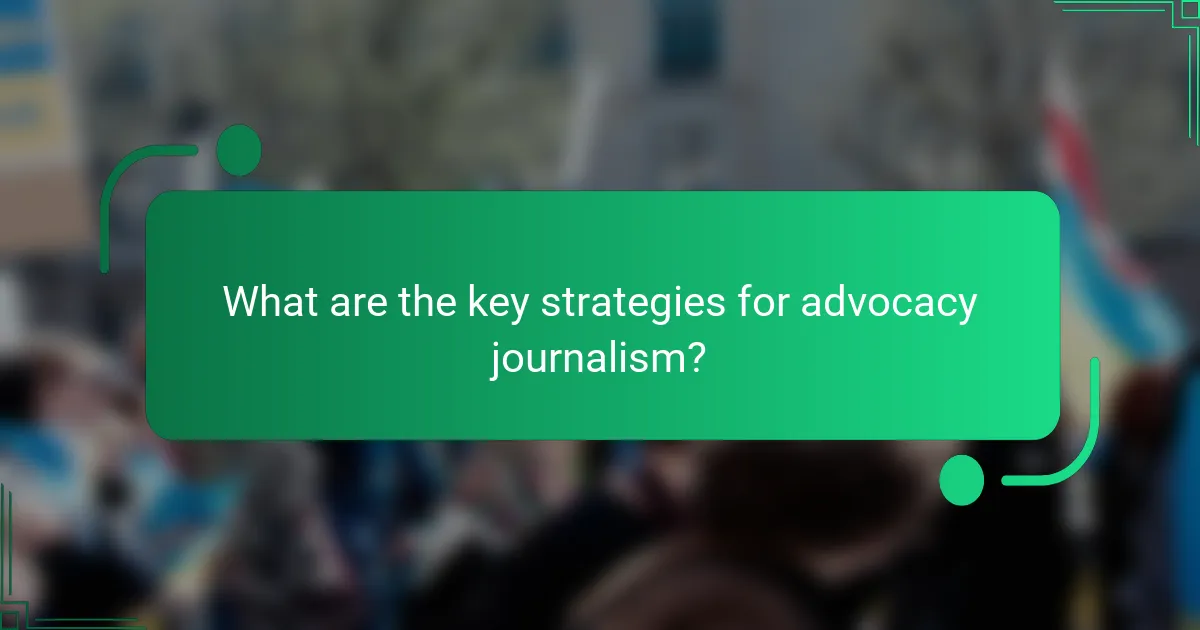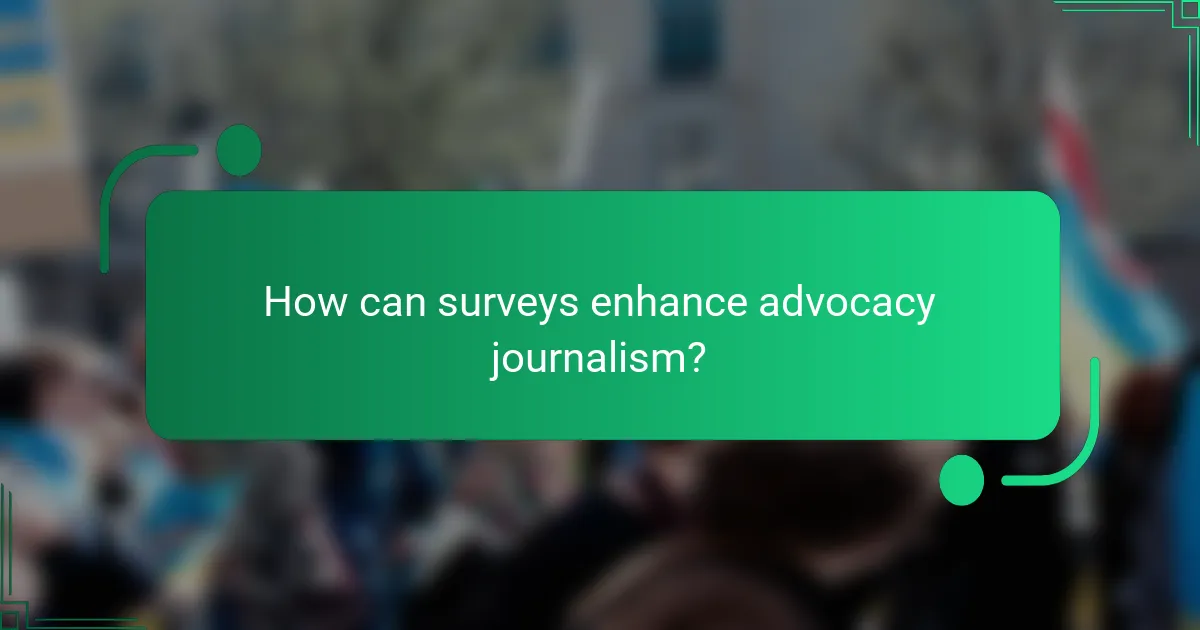Advocacy journalism plays a crucial role in addressing social issues by focusing on audience insights and community needs. By employing surveys and data analytics, journalists can tailor their narratives to resonate with their readers, ensuring that the content is both relevant and impactful. Engaging with stakeholders and utilizing effective tools for audience analysis further enhances the ability to mobilize support for important causes.

What are the key strategies for advocacy journalism?
Key strategies for advocacy journalism include understanding audience needs, engaging with community stakeholders, and leveraging data analytics. These approaches help journalists effectively communicate issues and mobilize support for causes.
Utilizing audience surveys
Audience surveys are essential for gathering insights into the preferences and concerns of the target demographic. By designing clear and concise surveys, journalists can identify key issues that resonate with their audience, ensuring that content is relevant and impactful.
Consider using online survey tools to reach a broader audience quickly. Aim for a response rate of around 10-20% for meaningful data, and be sure to analyze the results to inform your storytelling and advocacy strategies.
Engaging with community stakeholders
Engaging with community stakeholders helps build trust and fosters collaboration. This can include local organizations, activists, and residents who are directly affected by the issues being reported on.
Establish regular communication channels, such as community meetings or forums, to gather diverse perspectives. This engagement not only enriches the reporting but also strengthens the advocacy efforts by creating a sense of shared purpose.
Leveraging social media analytics
Social media analytics provide valuable data on audience engagement and sentiment. By monitoring metrics such as shares, likes, and comments, journalists can gauge which topics resonate most and adjust their strategies accordingly.
Utilize tools like Google Analytics or social media insights to track performance. Focus on content that generates high engagement rates, and consider conducting A/B testing to refine messaging and formats.
Conducting needs assessments
Conducting needs assessments involves evaluating the specific requirements and challenges faced by the community. This process helps identify gaps in information and areas where advocacy is most needed.
Use qualitative methods, such as interviews and focus groups, alongside quantitative data to create a comprehensive picture. Regular assessments can guide ongoing reporting efforts and ensure that advocacy initiatives are aligned with community needs.

How can surveys enhance advocacy journalism?
Surveys can significantly enhance advocacy journalism by providing insights into audience needs and preferences. They allow journalists to tailor their stories to resonate with their readers, ensuring that the content is relevant and impactful.
Identifying audience interests
Surveys help identify the specific interests of an audience, allowing journalists to focus on topics that matter most to their readers. By asking targeted questions, journalists can gather data on what issues are currently resonating with the community.
For instance, a survey might reveal that a significant portion of the audience is concerned about environmental issues. This insight can guide journalists to prioritize stories related to climate change or local conservation efforts.
Measuring impact of stories
Surveys can be used to measure the impact of published stories, providing feedback on how effectively they engage the audience. By asking readers about their reactions to specific articles, journalists can assess whether their work is influencing opinions or driving action.
For example, a follow-up survey after a major investigative piece can reveal if readers felt motivated to support a cause or change their behavior. This data is crucial for understanding the effectiveness of advocacy efforts.
Gathering feedback for improvement
Collecting feedback through surveys allows journalists to identify areas for improvement in their reporting. Readers can provide insights into what they liked or disliked, which can inform future content strategies.
Journalists should consider including open-ended questions in surveys to capture detailed feedback. This qualitative data can highlight specific aspects of storytelling that resonate with the audience, guiding more effective advocacy journalism.

What tools are effective for audience insights?
Effective tools for audience insights include online survey platforms and social media analytics tools that help gather and analyze data about audience preferences and behaviors. Utilizing these tools can significantly enhance advocacy journalism by aligning content with audience needs.
Google Forms for surveys
Google Forms is a user-friendly tool for creating surveys that can be easily shared via email or social media. It allows for customization of questions, including multiple choice, short answer, and rating scales, making it versatile for various research needs.
One advantage of Google Forms is that it automatically compiles responses into a Google Sheet, simplifying data analysis. Additionally, it is free to use, making it accessible for organizations with limited budgets.
SurveyMonkey for data collection
SurveyMonkey offers robust features for data collection, including advanced question types and analytics tools. It is particularly useful for larger surveys, as it can handle a significant number of responses and provides detailed reporting options.
While SurveyMonkey has a free tier, many of its advanced features require a paid subscription. This can be a consideration for organizations looking to maximize their budget while still obtaining valuable insights.
Hootsuite for social media insights
Hootsuite is a comprehensive social media management tool that provides insights into audience engagement and behavior across various platforms. It allows users to track metrics such as likes, shares, and comments, helping to gauge audience sentiment and preferences.
Using Hootsuite can help identify which types of content resonate most with audiences, enabling more targeted advocacy efforts. However, it requires a subscription for full access to its analytics features, which is an important factor for budgeting.

What are the best practices for conducting needs assessments?
Effective needs assessments identify the specific requirements and expectations of a target audience. Best practices include defining demographics, analyzing existing data, and incorporating qualitative interviews to gather comprehensive insights.
Defining target demographics
Understanding target demographics is crucial for tailoring advocacy journalism efforts. This involves identifying key characteristics such as age, gender, income level, education, and geographic location. For example, a survey targeting urban youth may focus on different issues compared to one aimed at rural seniors.
Utilize tools like surveys and social media analytics to gather demographic information. This data helps in creating content that resonates with the audience, ensuring that the advocacy message is relevant and impactful.
Analyzing existing data sources
Before conducting new research, review existing data sources to gain insights into audience needs. This can include reports from government agencies, academic studies, and previous surveys. Analyzing this information can reveal trends and gaps that inform your needs assessment.
Consider using publicly available databases or industry reports to gather quantitative data. This approach can save time and resources, allowing you to focus on areas that require deeper exploration through primary research.
Incorporating qualitative interviews
Qualitative interviews provide rich, detailed insights that quantitative data may overlook. Conducting interviews with key stakeholders, community leaders, or audience members can uncover nuanced perspectives on their needs and challenges. Aim for a diverse range of interviewees to capture varied viewpoints.
Prepare open-ended questions that encourage discussion and allow interviewees to express their thoughts freely. This method not only enhances understanding but also builds rapport with the community, fostering trust and engagement in your advocacy efforts.

How can advocacy journalism adapt to audience needs?
Advocacy journalism can adapt to audience needs by focusing on creating relevant content, actively seeking feedback, and adjusting how often content is published. This approach ensures that the journalism resonates with the audience and addresses their specific concerns and interests.
Creating tailored content
Creating tailored content involves understanding the unique interests and issues of your audience. Conduct surveys or utilize audience insights to identify topics that matter most to them, ensuring that your articles reflect their values and concerns.
For instance, if your audience is primarily concerned with environmental issues, focus on local sustainability initiatives or climate change impacts in their community. This targeted approach can increase engagement and foster a sense of connection with your readers.
Implementing feedback loops
Implementing feedback loops is crucial for refining advocacy journalism. Encourage your audience to share their thoughts through comments, social media, or direct surveys after they consume your content. This feedback can provide valuable insights into what resonates and what needs improvement.
Consider hosting regular Q&A sessions or feedback forums where readers can voice their opinions and suggest topics. This not only enhances content relevance but also builds a loyal community around your journalism.
Adjusting publication frequency
Adjusting publication frequency can significantly impact audience engagement. Analyze your audience’s consumption patterns to determine how often they prefer to receive updates. Some may prefer daily content, while others might find weekly or bi-weekly publications more manageable.
Experiment with different schedules and monitor engagement metrics to find the optimal frequency. Avoid overwhelming your audience with too much content, as this can lead to disengagement. Instead, aim for a consistent rhythm that keeps your audience informed without feeling inundated.

What are the ethical considerations in advocacy journalism?
Ethical considerations in advocacy journalism involve balancing the promotion of social causes with the responsibility to provide accurate and fair reporting. Journalists must navigate potential biases while ensuring their work serves the public interest without misleading audiences.
Objectivity and Bias
Maintaining objectivity is crucial in advocacy journalism. While the intent is to support a cause, journalists should strive to present facts fairly and avoid letting personal beliefs overshadow the truth. This balance helps build credibility and trust with the audience.
To mitigate bias, journalists can employ techniques such as fact-checking, seeking diverse perspectives, and disclosing any potential conflicts of interest. For instance, if a journalist is involved with a nonprofit organization, they should openly communicate this relationship to their audience.
Transparency and Accountability
Transparency in the reporting process enhances accountability in advocacy journalism. Journalists should clearly outline their sources, methodologies, and any affiliations that may influence their work. This openness allows readers to assess the reliability of the information presented.
Accountability also involves correcting errors promptly and acknowledging when reporting may have inadvertently misled the audience. Establishing a feedback mechanism can help journalists remain responsive to public concerns and improve their practices.
Impact on Vulnerable Populations
Advocacy journalism often focuses on marginalized or vulnerable groups, raising ethical questions about representation and voice. Journalists must be cautious not to exploit these populations for sensationalism or personal gain. Instead, they should aim to empower these communities by amplifying their voices and stories.
When covering sensitive issues, it is essential to approach subjects with empathy and respect, ensuring that the portrayal is accurate and dignified. Engaging with community members during the reporting process can help ensure that their perspectives are authentically represented.
Legal and Regulatory Considerations
Advocacy journalists must also be aware of legal and regulatory frameworks that govern their work. This includes understanding defamation laws, privacy rights, and any applicable regulations regarding funding and sponsorships. Failure to comply with these laws can lead to legal repercussions and damage to credibility.
In many countries, such as the United States, there are specific protections for journalists, but these can vary significantly by region. Familiarity with local laws and ethical guidelines is essential for responsible reporting in advocacy journalism.
